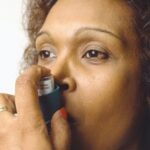Take 4 Steps to Protect Workers from Work-Related Asthma

Children aren’t the only ones who get asthma’adults can also suffer from this respiratory condition. And in many cases, adult asthma is work-related. (Read about a British study that found that one in six cases of adult-onset asthma is linked to the workplace.)
According to the Canadian Lung Association, there are two kinds of work-related asthma:
- Occupational asthma: Some people develop asthma for the first time because of something in their workplace, such as paint, fumes or dust. That is, they didn’t have asthma when they started the job, but something at work gave them the condition. (Read about a worker who developed asthma while working at a fertilizer plant.)
- Work-exacerbated asthma: People who already have asthma may find that something at work makes their symptoms worse (also called work-aggravated asthma).
To protect workers from both kinds of work-related asthma, take these four steps:
Step #1: Try to remove the substances or things that can cause asthma from the workplace, such as by replacing them with safer alternatives.
Step #2: Maintain good indoor air quality in the workplace by using ventilation to remove asthma-causing substances from the air in the workplace. For example, install extractor fans that pulls fumes and dust from the air. Also, store dangerous chemicals in a fume cupboard.
Step #3: Provide vulnerable workers with appropriate respiratory PPE such as masks or respirators that can cut down their exposure to things that cause or aggravate asthma.
Step #4: Educate workers on the signs and symptoms of work-related asthma. Explain that if they notice any of these symptoms, they should see a doctor right away.
The Canadian Lung Association has a lot of valuable information on work-related asthma, including:
- Jobs that are high risk for work-related asthma and the substances those jobs deal with that can cause or aggravate asthma
- The signs and symptoms of work-related asthma
- How work-related asthma is diagnosed and treated.